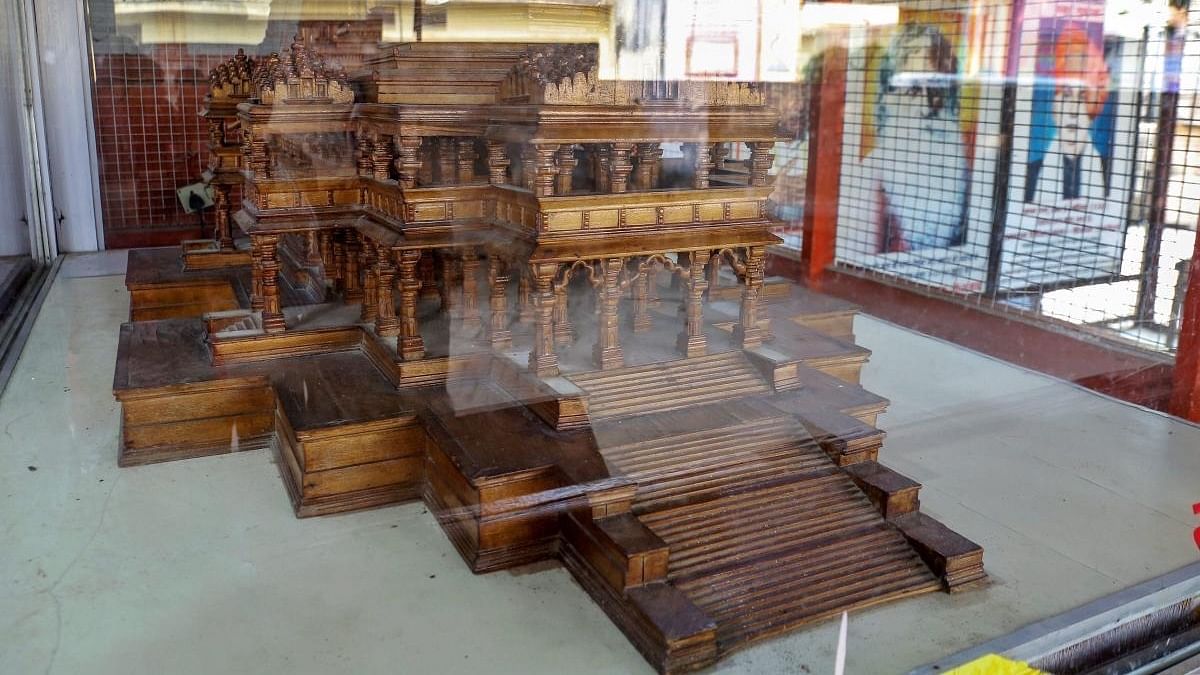
A wooden model of the 'Ram temple' in a glass encasement, at the Ram Janmabhoomi Nyas-run workshop at Karsevakpuram in Ayodhya.
Credit: PTI Photo
Ayodhya: Ayodhya native Aarti religiously polishes a block of ornately carved stone weathered over the years as curious visitors walk around at a workshop running in the holy city for more than 30 years.
”These stones will be sent to the site of construction of the Ram temple being built in Ayodhya. We feel good that we are contributing to it,” Aarti told PTI while working.
She is among a group of women who perform this job every day from 8 am to 5 pm with an hour-long lunch break in between at Ram Janmabhomi Nyas-run 'karyashala' in Ayodhya's Karsevakpuram.
However, Aarti and a few other women workers put in 'extra 10 minutes' even after the official closing time of work.
”It (extra time) is for bhagwan ji (the almighty),” says Aarti, who has been working on burnishing these faded stones for more than a year now.
With an iron blade, she patiently removes inch by inch the black marks that have settled on the surface of the beautifully carved stone, a laborious job that tests both her physical strength and patience.
”Our wrist pains, but we rest our hands briefly in between,” said Rita Devi, another worker employed on the job for which they get Rs 12,000 a month.
The Supreme Court in a historic verdict in 2019 paved way for the construction of the Ram temple by a trust, and ruled that an alternative five-acre plot be given for a mosque in the Hindu holy town.
Much has changed in Ayodhya since the verdict, but Karsevakpuram remains a curiosity corner of Ayodhya.
An excited Ayodhya is eagerly waiting for the consecration ceremony of the Ram temple on January 22, and devotees and other visitors are pouring in from various parts of the country for a 'darshan' of the Ram Lalla, and catch a glimpse of the under-construction temple.
Many of them also visit the Karsevakpuram workshop, some out of devotion, other pulled in by sheer curiosity. Local guides also bring in visitors to the sprawling 'Karyashala', which also houses a wooden model of the originally proposed 'Ram temple'.
Octogenarian Annu Bhai Sompura, in-charge of the workshop, said that though several blocks of carved stones have been 'sent to the construction site after being polished', the 'karyashala' still draws people in large numbers from different parts of the country.
”Huge number of people still come to see this place, the stones, the objects on display and first-timers enquire inquisitively about the significance of the workshop,” he claimed.
The group of women who polish stones are from Ayodhya while male workers, who polish and also do some chiselling work, have come from Rajasthan, Sompura said.
The artisans works from 8 am till 5 pm, and halt work only on days of Amawasya (New Moon Day). The Ram Janmabhoomi Nyas is supported by the Vishwa Hindu Parishad.
While Sompura claimed that some of these stones will be used in the main temple being built by the Shri Ram Janmabhoomi Teerth Kshetra, there was no official word on it from the trust yet.
An official source said, as the dimension of the Ram temple has increased from the one proposed earlier by the Nyas, these stones will be 'used in construction of other structures' that will come up in the 70-acre temple complex.
Some of the offices of the temple trust are operating from the Karyashala site in temporary structures.
One such structure carried a poster, bearing the logo of the trust and an image of the envisioned temple with a label — 'Pran Pratishtha Samaroh Samvad Kendra Sri Ram Janmabhoomi Teerth Kshetra'.
The temple complex, built in the traditional Nagara style, will be 380 feet long (east-west direction), 250 feet wide and 161 feet high, Ram temple trust general secretary Champat Rai told reporters here on December 26.
Each floor of the temple will be 20 feet high and will have a total of 392 pillars and 44 gates, he added.
The wooden model of a temple earlier proposed by the Nyas, is kept in front of an old stone block bearing an inscription, installed on two pillars at the workshop which reads — the temple, once built, will be 268 feet long, 140 feet wide and 128 feet high, from the ground to the apex point (shikhar) and will have a total of 212 pillars.
The dimensions, as proposed by the temple trust set up after the 2019 verdict, are much larger.
At the workshop, some of the remaining blocks of pink sandstones, which were carved intricately in the early 90s, got darkened over the decades, but these will be cleaned up too.
Sompura said ceiling blocks bearing beautiful floral motifs 'have been shifted' to the construction site.
Many visitors also look curiously at a heavy bell kept in an enclosure at the workshop site, bearing 'Jai Shriram' in bold red letters, and names of some people embossed on it.
A trust official at the site said the big bell was donated for the temple and was brought to Ayodhya from Tamil Nadu through a yatra.
Raj Laxmi Manda, an advocate and bike rider, said that she had accompanied the yatra when the 6.13-quintal bell was brought to Ayodhya. “It is 4.5-ft high and 3.5-ft wide,” she said with pride.